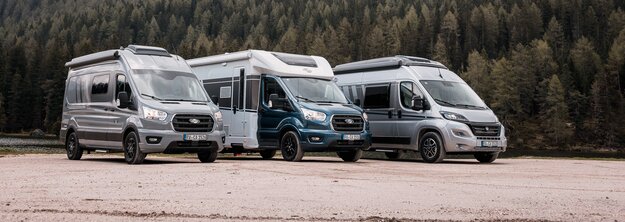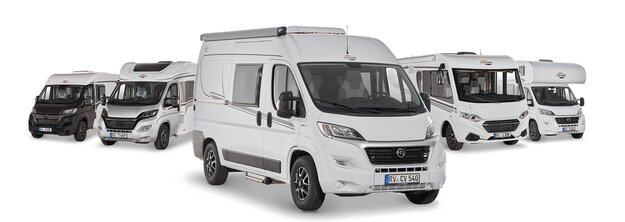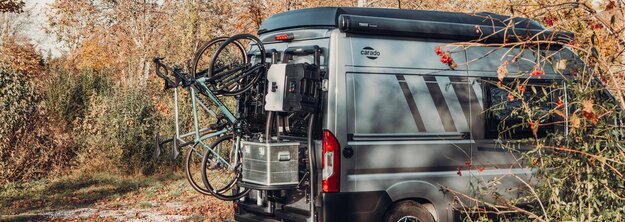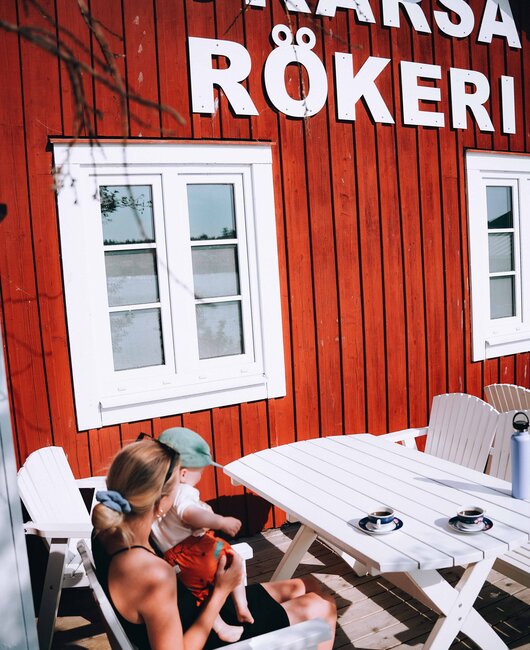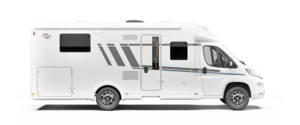PROFILE
![]() Travellers:
Travellers:
2 adults and 2 small children (Carolin and Sebastian, Emil and Matts)
![]() Vehicle:
Vehicle:
Carado T459
![]() Travel period:
Travel period:
5,5 weeks in June/July 2023
![]() Kilometres travelled:
Kilometres travelled:
approx. 5,800 km (including ferry journeys)
![]() Starting point:
Starting point:
Oy-Mittelberg im Allgäu
![]() Stopovers:
Stopovers:
Timmendorf Strand, Lübeck (DE); Kopenhagen (DK); Hasslö, Lönneberga, Stockholm Uppsala (SE)
![]() Endpoint:
Endpoint:
Kristiansand (NO)
Caro Kammermeier is a content creator and mother of twins. On her Instagram channel @caoxo, she takes her community along on her journey between love of nature, mindfulness and an active lifestyle. This year's Scandinavian round trip of the camping-experienced influencer and her family is exactly in this area of tension.

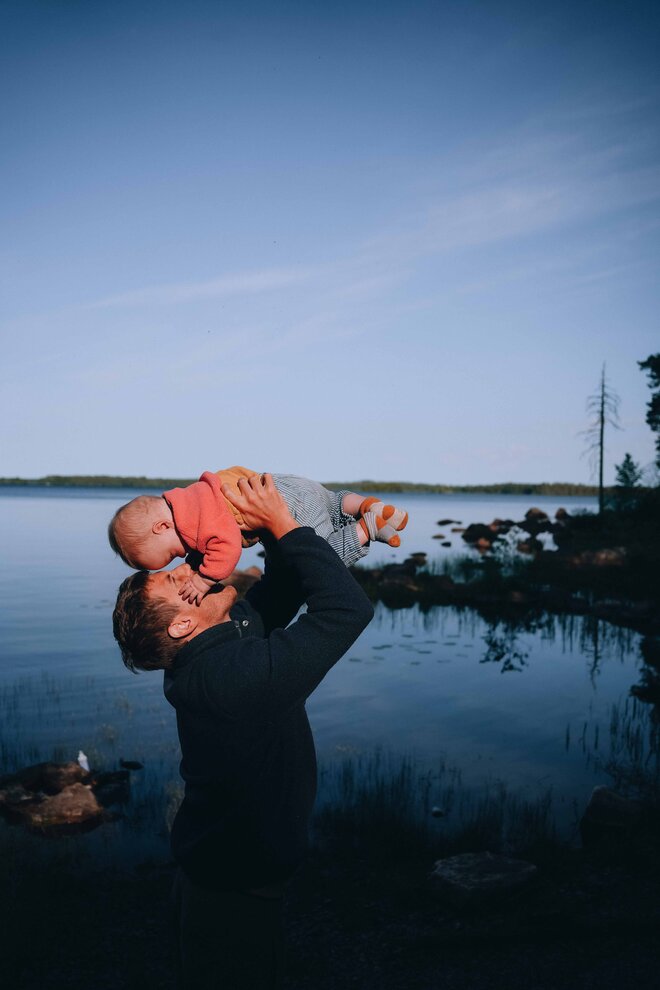
Hello, Caro. Five and a half weeks of Scandinavia are behind you and your family. Please give us a brief overview of your trip - the most important stops and your route.
Our itinerary was divided into various stages.
Stage 1: From the Allgäu to the north
Our journey began at home in the Allgäu and initially took us to the very north of Germany. After a short stay at Timmendorfer Strand, including a cycle tour to Lübeck, we continued our journey via the island of Fehmarn by ferry to Denmark.
Stage 2: Denmark - On the way to Copenhagen
Once we arrived in Denmark, we travelled quickly towards Copenhagen. We spent a few days there and enjoyed the beauty of the city.
Stage 3: Sweden - From Copenhagen to Stockholm
After Copenhagen, we crossed the impressive Öresund Bridge and reached Sweden. Our route took us along the south coast before turning inland. A special stopover was Lönneberga before we reached our destination of Stockholm. We were particularly impressed by the stretch of coast north of Stockholm, the so-called High Coast.
Stage 4: Northwards - from the coast inland
After a few days on the coast, we travelled inland again towards Norway. We experienced the Midsummer Festival in Åre and undertook our first mountain tours, but were also confronted with cold and bad weather.
Stage 5: Trondheim - a highlight of the trip
Trondheim proved to be the highlight of our city visits on the trip. The city impressed us with its tranquillity, beautiful houses and an immediate feel-good atmosphere.
Stage 6: Atlantic Road - stunning coastal landscape
We continued our journey along the Atlantic Road, a scenic route with numerous small and large bridges. We recommend travelling early in the morning or late in the evening to avoid the heavy traffic.
Stage 7: The fjords of Norway
We immersed ourselves in the land of fjords and were particularly impressed by the Aurdal Fjord with its many small branches.
Stage 8: Norwegian mountains and farewell to Norway
To satisfy our passion for mountain hikes, we visited Sognefjell, a beautiful little pass road that took us to the foot of a glacier and was the ideal starting point for hikes and exploration tours.
Our unforgettable time in Norway ended in Kristiansand, where we took the ferry back to Denmark and rounded off our trip.
Can you give us an insight into your additional travel costs - apart from petrol and the like?
1. ferry Denmark: approx. 100 euros
2. Öresund Bridge: approx. 80 euros
3. small ferry connections in Norway: approx. 40 euros in total
4. ferry Kristiansand-Hirtshals: approx. 280 euros
How high were your costs while travelling compared to your expenses in Germany?
Compared to our previous trips, the prices in Scandinavia didn't actually differ that much from German prices. We hardly noticed any differences when it came to diesel. And food prices are about the same as in German organic food shops.
What is still noticeable is the higher cost of alcohol and restaurant meals. As we cooked almost exclusively in the motorhome during our trip, these expenses were less relevant for us. However, it is important to note that prices in Scandinavia can vary depending on the region, with large cities often being more expensive than rural areas.

You and your partner are on an active holiday, but you are also travelling with two small children. How do you organise your trips so that all needs are taken into account?
Our approach to an active holiday with children is characterised by a conscious approach to slow travelling, which aims to avoid stress on holiday and take into account the needs of all family members. We usually plan our travel very spontaneously and often make our decisions in the morning, based on the current circumstances.
We are guided by a natural rhythm set by the children. To meet their need for closeness and their joy of discovery, we always have stretchers with us. Our children feel comfortable and content in them as they explore the world at close quarters.
We have consciously freed ourselves from the pressure of having to head for fixed destinations or stay overnight in certain places. When our boys don't feel like driving anymore, we take the liberty to stop, make ourselves comfortable on site and continue later. We are flexible and adapt our itinerary to the needs of our family to make sure everyone is relaxed and happy.


You were on the road with the T459. What advantages did your vehicle have for you?
The Carado T459 was the perfect vehicle for our trip and we really appreciated the benefits. The large bed in the back, which felt like its own room, was particularly practical. This allowed us to easily put our children to bed, darken the room and cook and relax in the front of the vehicle at the same time.
In addition, the T459 offered plenty of space. In the rear garage we could easily store bicycles, a bicycle trailer, tables, chairs and much more. Upstairs, there was enough space to spread out a crawling blanket for the children, so they had plenty of room to play. This generous amount of space made our trip really enjoyable and relaxing.

Which top spots will you remember forever?
I have put my favourite spot in a few pictures, just look at them, they speak for themselves. Another city that surprised us in a positive way was Trondheim. We felt at home here from the very first moment.
How was it in Scandinavia with the campsites or the free standing in nature? Where did you spend the night?
In fact, theory and practice differ somewhat here. Even though only tent campers are legally entitled to the Everyman's Right, wild camping is practised and widely accepted. About every three to four days we were at a campsite or a paid pitch to fill up with water or empty the toilet. Since there are a lot of campers on the road, the municipalities now restrict the right of everyman in some (too) crowded places. We found most of the free pitches via "park4night".
What every camping traveller should always keep in mind: We have to be considerate of the environment and the local people. And that starts with the fact that we always have to take our rubbish with us and leave the site clean.
What tips can you give other families with young children for long-distance travel?
Our stretchers and our bike trailer and jogger are indispensable for us as they give us the mobility we need to explore the surroundings around our camper van.
Although we have been lucky with the weather, it is often cold and rainy in countries like Norway and Sweden. Therefore, we recommend everyone to bring a good wind-and-weather outfit. This makes it possible to do outdoor activities with the children even in bad weather.
In addition, we are always well prepared and have a first-aid kit with us. It is reassuring to be prepared for all eventualities, especially when travelling with children.


Your holidays in one motif: Which is your favourite picture - and why?
When we became parents, we resolved to show our children the things we love ourselves. This picture will always remind us that we showed the twins the world at an early age and at the same time gave them closeness to nature by travelling with the camper van.
For us, travelling by motorhome simply means personal freedom and being close to nature. These are values that we want to pass on to our boys.

Do you have some data about the trip that other travellers could use for their planning?
During our trip we covered a total of 5,800 kilometres. A special feature in Norway is the maximum speed of 70 kilometres per hour, which meant that we had to plan significantly more time for comparable distances than in Germany.
A helpful tip for travellers in Norway: The possibility to refill gas is available at only a few petrol stations. It is therefore advisable to plan well in advance where and when you can take advantage of this opportunity to avoid unexpected problems.
You had your bikes on board. What do you need to think about, how did you stow your bikes - and the trailer for the kids - and what tools do you think are essential?
We stored the bikes in the rear garage of our camper van. To save space, we removed the front wheels of the bikes so they would fit easily into the garage. The trailer, on the other hand, did not need to be dismantled and also fit into the rear garage without any problems.
Regarding the tools, it was important for us to be well prepared. On the road, we had a small toolbox with special bicycle tools, which proved extremely useful when we were confronted with a defect. We also had our floor pump with us, which proved particularly useful on longer journeys. Likewise, a repair kit or a spare inner tube should not be missing from the tool arsenal.
We also had special bike cleaning products with us, even though they were not used due to the nice weather. Nevertheless, we recommend always having them with you, as they can be extremely useful in bad weather conditions.
Storelocator
Enter your Postcode now and get in soon

